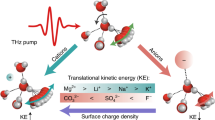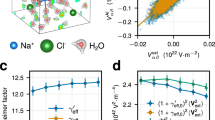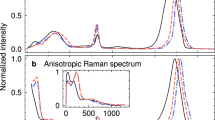Abstract
The structural and dynamical properties of water are known to be affected by ion solvation. However, a consistent molecular picture that describes how and to what extent ions perturb the water structure is still missing. Here we apply 2D Raman–terahertz spectroscopy to investigate the impact of monatomic cations on the relaxation dynamics of the hydrogen-bond network in aqueous salt solutions. The inherent ability of multidimensional spectroscopy to deconvolute heterogeneous relaxation dynamics is used to reveal the correlation between the inhomogeneity of the collective intermolecular hydrogen-bond modes and the viscosity of a salt solution. Specifically, we demonstrate that the relaxation time along the echo direction t1 = t2 correlates with the capability of a given cation to ‘structure’ water. Moreover, we provide evidence that the echo originates from the water–water modes, and not the water–cation modes, which implies that cations can structure the hydrogen-bond network to a certain extent.
This is a preview of subscription content, access via your institution
Access options
Subscribe to this journal
Receive 12 print issues and online access
$259.00 per year
only $21.58 per issue
Buy this article
- Purchase on Springer Link
- Instant access to full article PDF
Prices may be subject to local taxes which are calculated during checkout




Similar content being viewed by others
References
Debenedetti, P. G. Supercooled and glassy water. J. Phys. Condens. Matter 15, R1669–R1726 (2003).
Stanley, H. E. et al. Liquid polyamorphism: possible relation to the anomalous behaviour of water. Eur. Phys. J. Special Topics 161, 1–17 (2008).
Sutera, S. P. & Skalak, R. The history of Poiseuille's law. Annu. Rev. Fluid Mech. 25, 1–20 (1993).
Jones, G. & Dole, M. The viscosity of aqueous solutions of strong electrolytes with special reference to barium chloride. J. Am. Chem. Soc. 51, 2950–2964 (1929).
Jenkins, H. D. B. & Marcus, Y. Viscosity B-coefficients of ions in solution. Chem. Rev. 95, 2695–2724 (1995).
Gurney, R. W. Ionic Processes in Solution (McGraw–Hill, 1953).
Frank, H. S. & Wen, W.-Y. Ion–solvent interaction. Structural aspects of ion–solvent interaction in aqueous solutions: a suggested picture of water structure . Discuss. Faraday Soc. 24, 133–140 (1957).
Struis, R. P. W. J., Bleijser, J. D. & Leyte, J. C. 25Mg2+ and 35Cl− quadrupolar relaxation in aqueous MgCl2 solutions at 25 °C. 2. Relaxation at finite MgCl2 concentrations. J. Phys. Chem. 93, 7943–7952 (1989).
Buchner, R., Chen, T. & Hefter, G. Complexity in ‘simple’ electrolyte solutions: ion pairing in MgSO4(aq). J. Phys. Chem. B 108, 2365–2375 (2004).
Wachter, W., Kunz, W., Buchner, R. & Hefter, G. Is there an anionic Hofmeister effect on water dynamics? Dielectric spectroscopy of aqueous solutions of NaBr, NaI, NaNO3, NaClO4, and NaSCN. J. Phys. Chem. A 109, 8675–8683 (2005).
Turton, D. A., Hunger, J., Hefter, G., Buchner, R. & Wynne, K. Glasslike behavior in aqueous electrolyte solutions. J. Chem. Phys. 128, 161102 (2008).
Näslund, L.-Å. et al. X-ray absorption spectroscopy study of the hydrogen bond network in the bulk water of aqueous solutions. J. Phys. Chem. A 109, 5995–6002 (2005).
Mancinelli, R., Botti, A., Bruni, F., Ricci, M. A. & Soper, A. K. Perturbation of water structure due to monovalent ions in solution. Phys. Chem. Chem. Phys. 9, 2959–2967 (2007).
Bruni, F., Imberti, S., Mancinelli, R. & Ricci, M. A. Aqueous solutions of divalent chlorides: ions hydration shell and water structure. J. Chem. Phys. 136, 064520 (2012).
Omta, A. W., Kropman, M. F., Woutersen, S. & Bakker, H. J. Negligible effect of ions on the hydrogen-bond structure in liquid water. Science 301, 347–349 (2003).
Kropman, M. F. & Bakker, H. J. Effect of ions on the vibrational relaxation of liquid water. J. Am. Chem. Soc. 126, 9135–9141 (2004).
Park, S. & Fayer, M. D. Hydrogen bond dynamics in aqueous NaBr solutions. Proc. Natl Acad. Sci. USA 104, 16731–16738 (2007).
Moilanen, D. E., Wong, D., Rosenfeld, D. E., Fenn, E. E. & Fayer, M. D. Ion–water hydrogen-bond switching observed with 2D IR vibrational echo chemical exchange spectroscopy. Proc. Natl Acad. Sci. USA 106, 375–380 (2009).
Tielrooij, K. J., Garcia-Araez, N., Bonn, M. & Bakker, H. J. Cooperativity in ion hydration. Science 328, 1006–1009 (2010).
Stirnemann, G., Wernersson, E., Jungwirth, P. & Laage, D. Mechanisms of acceleration and retardation of water dynamics by ions. J. Am. Chem. Soc. 135, 11824–11831 (2013).
Zhang, R. & Zhuang, W. Cation effect in the ionic solution optical Kerr effect measurements: a simulation study. J. Chem. Phys. 140, 054507 (2014).
Heisler, I. A. & Meech, S. R. Low-frequency modes of aqueous alkali halide solutions: glimpsing the hydrogen bonding vibration. Science 327, 857–860 (2010).
Heisler, I. A., Mazur, K. & Meech, S. R. Low-frequency modes of aqueous alkali halide solutions: an ultrafast optical Kerr effect study. J. Phys. Chem. B 115, 1863–1873 (2011).
Bertie, J. E. & Lan, Z. Infrared intensities of liquids XX. The intensity of the OH stretching band of liquid water revisited, and the best current values of the optical constants of H2O(l) at 25 °C between 15,000 and 1 cm–1. Appl. Spectrosc. 50, 1047–1057 (1996).
Mazur, K., Heisler, I. A. & Meech, S. R. Thz spectra and dynamics of aqueous solutions studied by the ultrafast optical Kerr effect. J. Phys. Chem. B 115, 2563–2573 (2011).
Torre, R., Bartolini, P. & Righini, R. Structural relaxation in supercooled water by time-resolved spectroscopy. Nature 428, 296–299 (2004).
Fukasawa, T. et al. Relation between dielectric and low-frequency Raman spectra of hydrogen-bond liquids. Phys. Rev. Lett. 95, 197802 (2005).
Loring, R. F. & Mukamel, S. Selectivity in coherent transient Raman measurements of vibrational dephasing in liquids. J. Chem. Phys. 83, 2116–2128 (1985).
Hamm, P. & Zanni, M. T. Concepts and Methods of 2D Infrared Spectroscopy (Cambridge Univ. Press, 2011).
Hwang, H. Y. et al. A review of non-linear terahertz spectroscopy with ultrashort tabletop-laser pulses. J. Mod. Opt. 62, 1447–1479 (2015).
Kuehn, W. et al. Strong correlation of electronic and lattice excitations in GaAs/AlGaAs semiconductor quantum wells revealed by two-dimensional terahertz spectroscopy. Phys. Rev. Lett. 107, 067401 (2011).
Fleischer, S., Field, R. W. & Nelson, K. A. Commensurate two-quantum coherences induced by time-delayed THz fields. Phys. Rev. Lett. 109, 123603 (2012).
Tanimura, Y. & Mukamel, S. Two-dimensional femtosecond vibrational spectroscopy of liquids. J. Chem. Phys. 99, 9496–9511 (1993).
Blank, D. A., Kaufman, L. J. & Fleming, G. R. Fifth-order two-dimensional Raman spectra of CS2 are dominated by third-order cascades. J. Chem. Phys. 111, 3105–3114 (1999).
Golonzka, O., Demirdöven, N., Khalil, M. & Tokmakoff, A. Separation of cascaded and direct fifth-order Raman signals using phase-sensitive intrinsic heterodyne detection. J. Chem. Phys. 113, 9893–9896 (2000).
Kaufman, L. J., Heo, J., Ziegler, L. D. & Fleming, G. R. Heterodyne-detected fifth-order nonresonant Raman scattering from room temperature CS2 . Phys. Rev. Lett. 88, 207402 (2002).
Kubarych, K. J., Milne, C. J. & Miller, R. J. D. Fifth-order two-dimensional Raman spectroscopy: a new direct probe of the liquid state. Int. Rev. Phys. Chem. 22, 497–532 (2003).
Li, Y. L., Huang, L., Miller, R. J. D., Hasegawa, T. & Tanimura, Y. Two-dimensional fifth-order Raman spectroscopy of liquid formamide: experiment and theory. J. Chem. Phys. 128, 234507 (2008).
Frostig, H., Bayer, T., Dudovic, N., Eldar, Y. C. & Silberberg, Y. Single-beam spectrally controlled two-dimensional Raman spectroscopy. Nat. Photon. 9, 339–343 (2015).
Hamm, P. & Savolainen, J. Two-dimensional-Raman–terahertz spectroscopy of water: theory. J. Chem. Phys. 136, 094516 (2012).
Hamm, P., Savolainen, J., Ono, J. & Tanimura, Y. Note: inverted time-ordering in two-dimensional-Raman–terahertz spectroscopy of water. J. Chem. Phys. 136, 236101 (2012).
Savolainen, J., Ahmed, S. & Hamm, P. Two-dimensional Raman–terahertz spectroscopy of water. Proc. Natl Acad. Sci. USA 110, 20402–20407 (2013).
Savolainen, J., Uhlig, F., Ahmed, S., Hamm, P. & Jungwirth, P. Direct observation of the collapse of the delocalized excess electron in water. Nat. Chem. 6, 697–701 (2014).
Funkner, S. et al. Watching the low-frequency motions in aqueous salt solutions: the terahertz vibrational signatures of hydrated ions. J. Am. Chem. Soc. 134, 1030–1035 (2012).
Finneran, I. A., Welsch, R., Allodi, M. A., Miller III, T. F. & Blake, G. A. Coherent two-dimensional terahertz–terahertz–Raman spectroscopy. Proc. Natl Acad. Sci. USA 113, 6857–6861 (2016).
Asbury, J. B. et al. Dynamics of water probed with vibrational echo correlation spectroscopy. J. Chem. Phys. 121, 12431–12446 (2004).
Yeremenko, S., Pshenichnikov, M. S. & Wiersma, D. A. Hydrogen-bond dynamics in water explored by heterodyne-detected photon echo. Chem. Phys. Lett. 369, 107–113 (2003).
Cowan, M. L. et al. Ultrafast memory loss and energy redistribution in the hydrogen bond network of liquid H2O. Nature 434, 199–202 (2005).
Eaves, J. D. et al. Hydrogen bonds in liquid water are broken only fleetingly. Proc. Natl Acad. Sci. USA 102, 13019–13022 (2005).
Schmidt, D. A. et al. Rattling in the cage: ions as probes of sub-picosecond water network dynamics. J. Am. Chem. Soc. 131, 18512–18517 (2009).
Torii, H. Ultrafast anisotropy decay of coherent excitations and the non-coincidence effect for delocalized vibrational modes in liquids. Chem. Phys. Lett. 323, 382–388 (2000).
Ito, H., Hasegawa, T. & Tanimura, Y. Calculating two-dimensional THz–Raman–THz and Raman–THz–THz signals for various molecular liquids: the samplers. J. Chem. Phys. 141, 124503 (2014).
Ito, H., Jo, J.-Y. & Tanimura, Y. Notes on simulating two-dimensional Raman and terahertz–Raman signals with a full molecular dynamics simulation approach. Struct. Dyn. 2, 054102 (2015).
Ikeda, T., Ito, H. & Tanimura, Y. Analysis of 2D THz–Raman spectroscopy using a non-Markovian Brownian oscillator model with nonlinear system–bath interactions. J. Chem. Phys. 142, 212421 (2015).
Ito, H. & Tanimura, Y. Simulating two-dimensional infrared–Raman and Raman spectroscopies for intermolecular and intramolecular modes of liquid water. J. Chem. Phys. 144, 074201 (2016).
Fourkas, J. T. Multidimensional Raman spectroscopies. Adv. Chem. Phys. 117, 235–273 (2001).
Pan, Z. et al. Low frequency 2D Raman–THz spectroscopy of ionic solution: a simulation study. J. Chem. Phys. 142, 212419 (2015).
Hamm, P. 2D-Raman–THz spectroscopy: a sensitive test of polarizable water models. J. Chem. Phys. 141, 184201 (2014).
Tröster, P., Lorenzen, K., Schwörer, M. & Tavan, P. Polarizable water models from mixed computational and empirical optimization. J. Phys. Chem. B 117, 9486–9500 (2013).
Acknowledgements
We thank P. J. M. Johnson for many insightful discussions. The work has been supported by the Swiss National Science Foundation (SNF) through the NCCR MUST.
Author information
Authors and Affiliations
Contributions
A.S., J.S and P.H. conceived and designed the experiments. A.S. and S.A. performed the experiments. A.S analysed the data. A.S. and P.H. co-wrote the paper. All the authors discussed the results and commented on the manuscript.
Corresponding author
Ethics declarations
Competing interests
The authors declare no competing financial interests.
Supplementary information
Supplementary information
Supplementary information (PDF 254 kb)
Rights and permissions
About this article
Cite this article
Shalit, A., Ahmed, S., Savolainen, J. et al. Terahertz echoes reveal the inhomogeneity of aqueous salt solutions. Nature Chem 9, 273–278 (2017). https://doi.org/10.1038/nchem.2642
Received:
Accepted:
Published:
Issue Date:
DOI: https://doi.org/10.1038/nchem.2642
This article is cited by
-
Two-dimensional infrared-Raman spectroscopy as a probe of water’s tetrahedrality
Nature Communications (2023)
-
Time-resolved terahertz–Raman spectroscopy reveals that cations and anions distinctly modify intermolecular interactions of water
Nature Chemistry (2022)
-
Macroscopic conductivity of aqueous electrolyte solutions scales with ultrafast microscopic ion motions
Nature Communications (2020)
-
Attenuation of THz Beams: A “How to” Tutorial
Journal of Infrared, Millimeter, and Terahertz Waves (2019)
-
Coupling between intra- and intermolecular motions in liquid water revealed by two-dimensional terahertz-infrared-visible spectroscopy
Nature Communications (2018)



